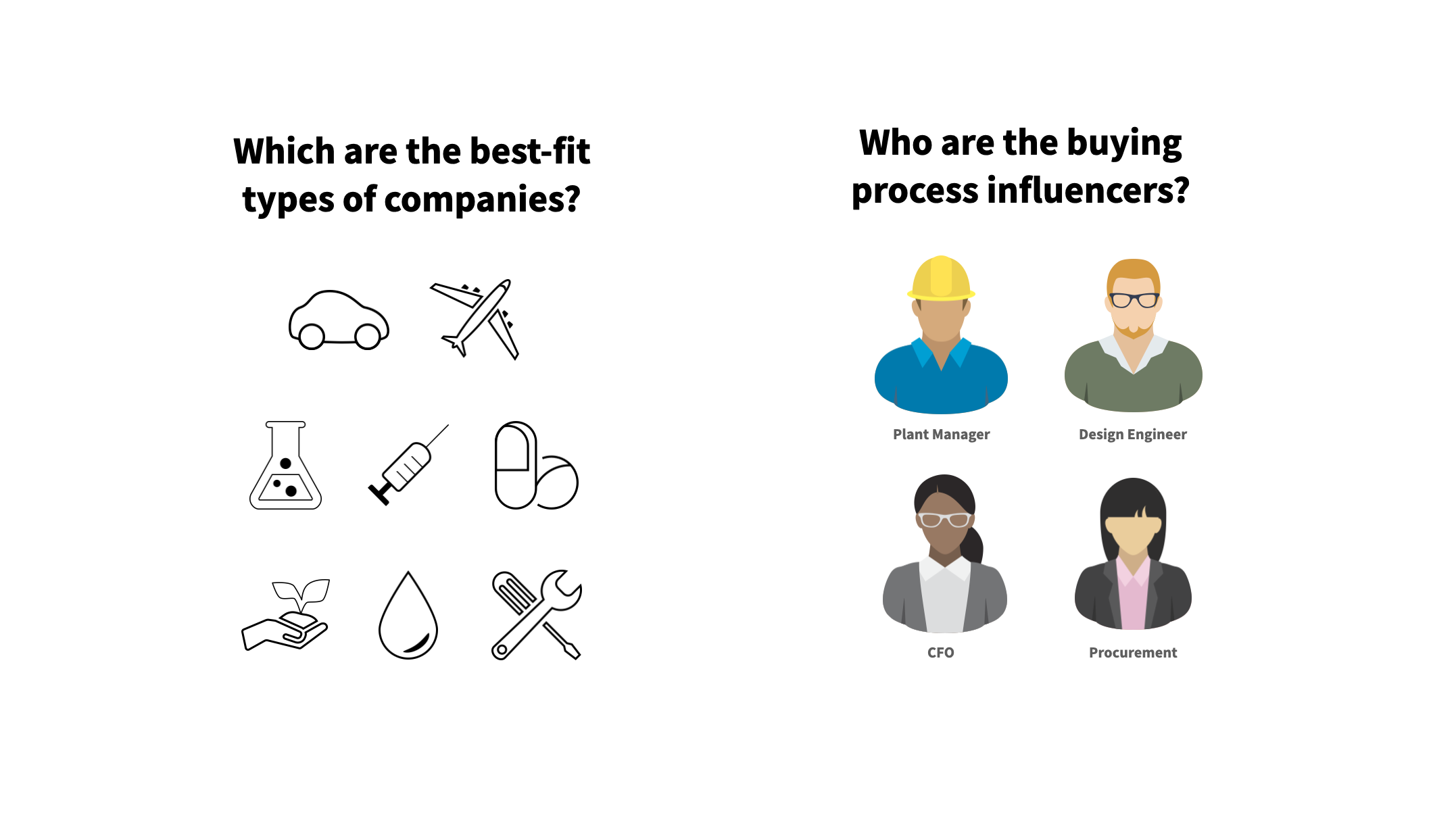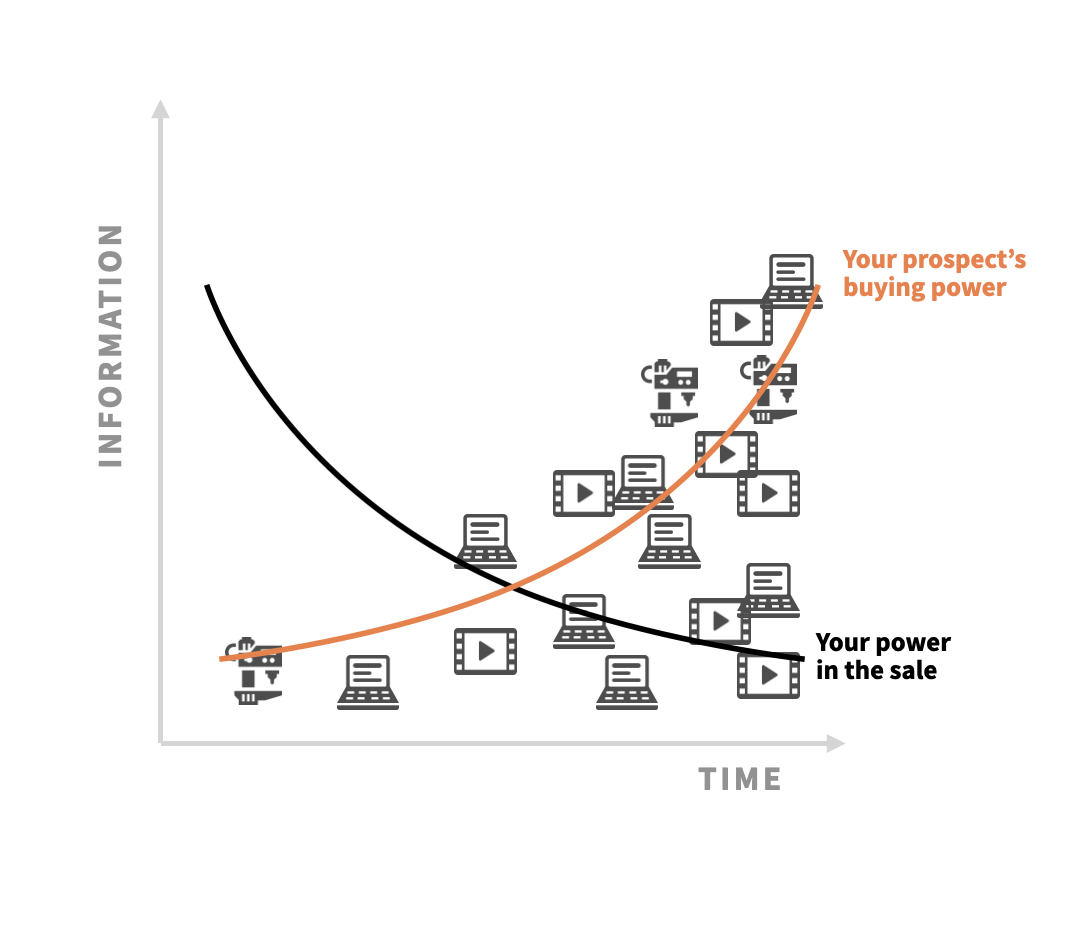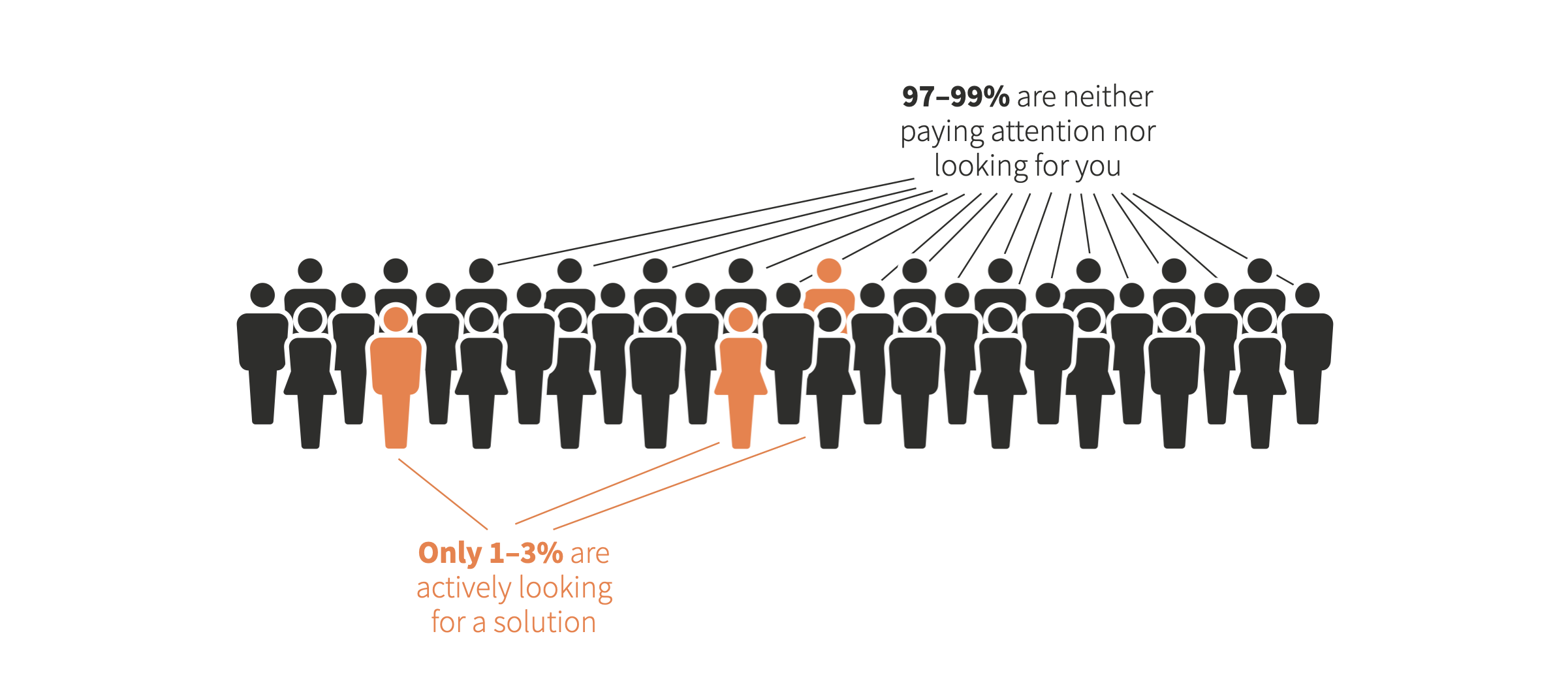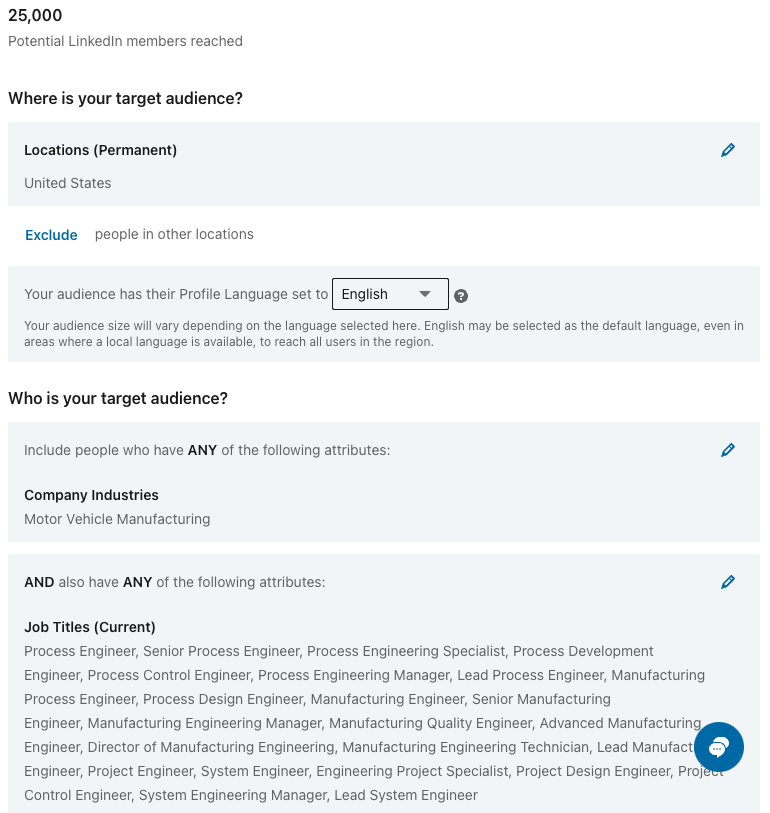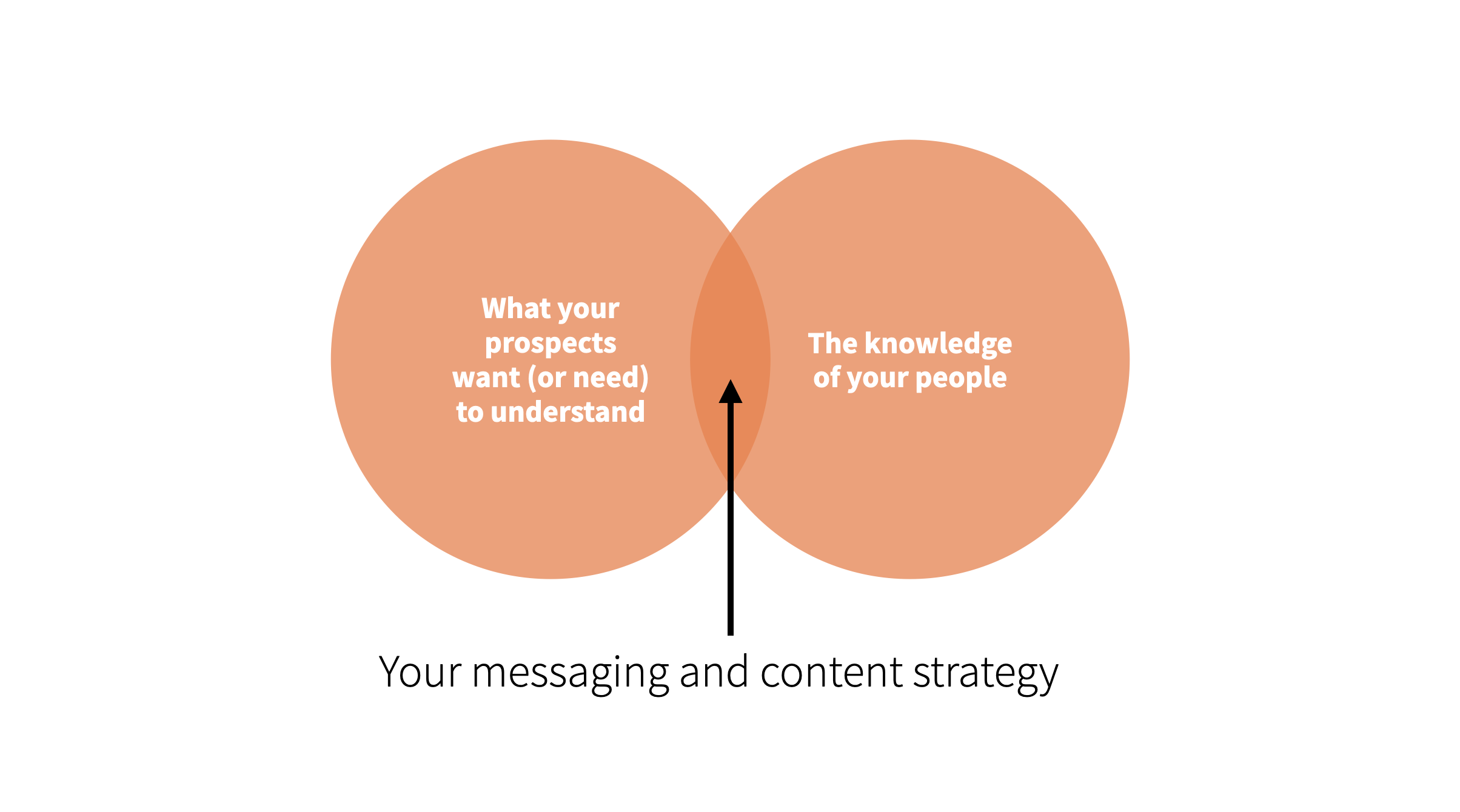What is demand generation and why is it so important for manufacturers?
Let’s walk through a thought exercise.
Think about your target account.
Which group of buying influencers is the most important to talk to? What problems do you solve for them?
For this example, imagine your answers were:
- Target account = General Motors
- Buying process influencers = process engineers
- The problem you solve = high scrap rates, which you help reduce by 5%
That GM process engineer (let’s call him Andy) is aware of his scrap problem, but isn’t in the market for new tooling. He does, however, like to scroll through Facebook on his lunch break.
Andy starts seeing a mix of ads from your company – educational articles, case studies and product videos. It’s clear you solve the exact problem he’s having at work.
Now, repeat that scenario over the course of six months.
GM’s scrap problem has been getting worse and frustrations are building.
Finally, Andy gets approval to replace the old tooling. Because of your Facebook ads, he’s familiar with your products and reaches out to you directly.
THAT’s the power of demand generation.
Why does this work?
Most of your prospective customers are like Andy. They have a problem you can help solve, BUT they aren’t currently in a buy cycle.
Yet, many industrial companies market to Andy as if he were looking to purchase tooling tomorrow.
If Andy were only seeing ads with pictures of your product that said, “Get a quote now,” that wouldn’t be memorable OR helpful for his current situation.
The scrap rate was a real problem. He needed guidance, not a sales pitch.
And upgrading tooling can be expensive and risky. He needed to trust you, too.
The ads he saw:
- Offered guidance through expert articles that actually helped Andy do his job better
- Built trust through case studies about how you solved problems for customers just like him
- Demonstrated how your tooling worked with technical product videos
Overtime, those small touch points built trust with Andy. When it came time to buy, he knew who you were, how you could help him and had some trust in your brand’s ability to solve his problem.
It’s a similar approach your top salesperson might take with a prospect. Send them helpful information over email. Take them out to dinner a few times to build a relationship. Invite them to your shop for a product demonstration.
The touch points on social media are much smaller, but they’re also less expensive, more frequent and SCALABLE.
There are tens of thousands of Andy’s out there seeing these same ads and having similar journeys. That scale is the advantage of a demand generation program.
But what about trade shows? Prospecting? Email?
A demand generation program on paid social doesn’t need to replace your current sales and marketing efforts, especially if they’re producing results.
Demand generation is an opportunity to amplify what you’re already doing.
There are a few key reasons why you should consider adding demand gen into your marketing mix:
- The buying process is changing
- Most of your buyers aren’t in buy-mode right now
- It’s an opportunity your competitors might not be taking advantage of, giving you an edge
The buying process is changing
More and more of the buying process is happening online. Young engineers are reading articles or watching videos before they’re talking to a sales rep about a solution.
As access to information increases for your customers, your “power” in the buying process decreases.
But that’s not necessarily a bad thing! You now have opportunities to help and influence your customers before they even talk to you. You can generate demand.
Most of your buyers aren’t in buy-mode right now
This was Andy’s situation in our example. Only about 1-3% of your potential buyers are looking for a solution right now. If your marketing is only geared toward them, you’re missing all the Andy’s who could be buying from you in six months.
Demand generation is an opportunity
Open Google and search for the “Facebook Ads Library.” Once there, search for your top competitor. You can see all the ads they’re running.
You can do this on LinkedIn, too. Just go to their company page, click “posts” and filter by “ads.”
Are they running ads? If so, would they have helped Andy in his situation?
Most industrial companies aren’t doing demand gen.
This means you have an opportunity to talk to your ideal customers where your competitors aren’t. At a trade show, you may be across the aisle from each other, but on Facebook? Your customers are only seeing YOU.
Why pay for ads when you can post on LinkedIn and Facebook for free?
There’s a big difference between organic and paid social media.
When you post organically on your LinkedIn page, LinkedIn can show that to whoever it wants. There’s no guarantee that all your followers will even see it.
LinkedIn also tends to suppress company page reach, because users would rather see updates from their friends and colleagues.
For example, Gorilla 76’s own LinkedIn page has over 4,000 followers, but our posts only get about 500 to 1,000 impressions when we’re regularly posting helpful content.
Paid social media comes with two major advantages:
- Controlled targeting
- Scale
Just look at this audience built in LinkedIn based on our earlier example:
That’s 25,000 people…
…with the exact right engineering titles…
…working in motor vehicle manufacturing.
And that’s only scratching the surface. With some more specific information about business goals, this audience could easily be scaled up or niched down.
Don’t forget, this is also guaranteed distribution. LinkedIn doesn’t show ads to whoever it wants to like it does with organic posts. It shows them to the audience you specified, which is MUCH larger and targeted than your organic following.
The pieces of a successful demand generation program for manufacturers
Before you start, two things need to be clear:
- How exactly does this program fit into your business goals?
- What’s your focus going to be?
Don’t do demand gen just to do it. This strategy won’t be effective unless it ties back to business goals. If one of your goals is growing your customer base in the automotive industry, your demand generation program should target that industry.
Which brings me to the second point: focus.
You probably have five to 10 industries or customer segments you could sell to. Demand gen and paid social are scalable, but you can’t boil the ocean here.
You need to focus on one audience to get started. Otherwise you’re going to dilute your efforts and spend way too much money on ads.
Once your goals and audience are clear, you can dive in.
There are three key components to a demand generation program:
- Developing your messaging: what do you need to say to your customers?
- Creating content: how are you going to communicate that message?
- Distribution: how are you going to make sure your ideal customers consume that content?
Developing your messaging
How do you want to position yourself in your market? What differentiates you? What problems do you solve for your customers?
These are all important questions you need to answer with your messaging, and the best way to answer them is by actually talking to your customers.
As a business owner, you’ve probably interacted with a lot of customers and have some really great assumptions about the above. But you need to validate those assumptions by actually talking to your customers. I’ve seen it happen many times: the business owner assumes one thing and their customer tells them another.
Their answers to the questions above become your messaging.
Next, you need to create content that communicates that message.
Creating content
We’ve written about content creation a LOT here at Gorilla, so if you’re interested in the nitty gritty, I’d recommend this article, or this one or even this one. However, I’m going to give the 30,000-foot view.
Content is critical for your demand gen success because:
- No one wants to be sold to
- It builds trust by showing your expertise
- It helps your customers do their jobs better, and helpful = memorable
Think back to Andy at the beginning of this piece. The ads he saw weren’t reminiscent of a used car salesman. They were full of expertise and insights from the company’s subject matter experts and customers. This content helped Andy start solving problems at work.
THAT’S what made him remember the brand. Not a flashy “get a quote” button.
Content can work like another salesperson on your team, offering helpful info to customers and guiding them through the sales journey.
So, what content do you need to create to do this? Look back to your messaging and audience.
If the problems you solve for your customers are highly complex…
…consider educational articles written by your own engineers to break it down.
If your target audience is primarily engineers who need to spec equipment into projects…
…consider more technical product videos and spec sheets.
If your solution is a large investment for your customers…
…consider social proof like case studies or video testimonials from other customers to put them at ease.
Once you have some content, it’s time to distribute it to your ideal customers.
Distribution
Gorilla 76 founder, Joe Sullivan, has a great analogy about the importance of distribution:
Imagine you’re opening a new restaurant. Your chef has worked in the best kitchens across Europe. Your waitstaff never lets a glass become empty. The finest linens and fresh centerpieces adorn your tables every night.
It’s a really classy, 5-star joint.
But…you’re located on a quaint side street and no one knows your restaurant even exists.
In that scenario, it makes perfect sense to put a little money into advertising this amazing restaurant, right? How can you expect people to find it on their own?
Manufacturers and restaurants are apples and oranges (or maybe more like apples and CNC machines,) but the principle still applies.
You’ve put so much work into making your business great. But what’s the point if your ideal customers aren’t aware of you?
You need to target these customers where they’re already spending time and deliver the right message with the right content.
Bonus: Analyze and iterate
Even after all this hard work, it’s still probably not going to be perfect. You need to analyze your ad performance to see what’s working best.
Then, you can test small adjustments to your copy, creative and content to optimize your ad performance.
When to expect results from demand generation
You might be thinking this sounds like a lot of work. And for Facebook or LinkedIn ads? Maybe you’ve tried them before and haven’t been impressed. Where are the results?
I’ll reference back to Andy again. He was seeing ads from the tooling provider for SIX months before he finally reached out. Although that’s only an example, it’s pretty typical for manufacturers who are running demand gen successfully.
There are a couple of reasons for this longer timeline to results for manufacturers:
- The amount of trust you need to build
- The length of your sales cycle
Sure, maybe B2C brands like Nike can expect to see results from paid social in 24 hours – buying a $75 pair of sneakers isn’t a high-risk investment.
Spending $100K on tooling or machinery is a completely different story.
How long would you expect it to take for your top salesperson to start building a relationship with a brand new target account? Now double that. That’s how long it takes to start building trust with your ideal customers online.
Once they trust you, how long does it take them to actually buy from you? For most manufacturers, it can be anywhere from three months to over a year. The longer your sales cycle, the longer it’s going to take to see real results (read: revenue) from your paid social demand gen program.
If you quit after 30 days, demand generation is always going to be tossed aside as a failure.
We recommend giving this type of program at LEAST six months to start gathering high intent leads. You’re literally generating demand here. That takes time, energy, and most importantly, patience.
We’ve talked about:
- What demand generation is
- Why it works for manufacturers
- And the pieces of a demand gen plan
This article is a great place to start, but if you want to chat with an expert about how this could work for your specific business, feel free to book a free consultation.
